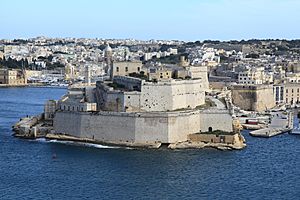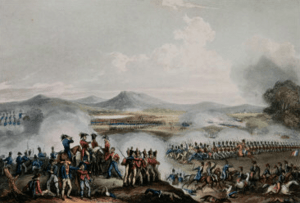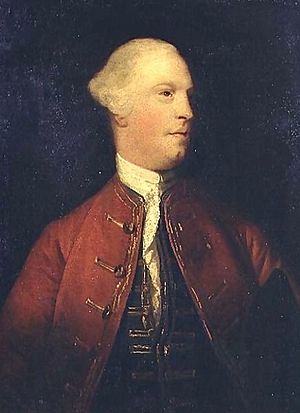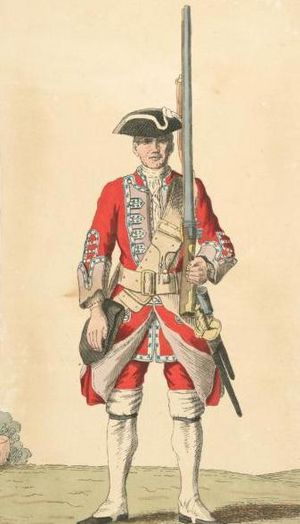48th (Northamptonshire) Regiment of Foot facts for kids
The 48th (Northamptonshire) Regiment of Foot was a famous British Army regiment. It was first formed in 1741. This group of soldiers later joined with the 58th (Rutlandshire) Regiment of Foot in 1881. Together, they became the Northamptonshire Regiment.
Quick facts for kids 48th (Northamptonshire) Regiment of Foot |
|
|---|---|
| Active | 1741 to 1881 |
| Country | |
| Branch | |
| Type | Line Infantry |
| Size | One battalion (two battalions 1803–1814) |
| Garrison/HQ | Gibraltar Barracks, Northampton |
| Nickname(s) | "The Heroes of Talavera", "Murray's Bucks", "The Surprisers", "Lacedemonians". |
| Colours | Buff Facings, Gold Braided Lace |
| March | Quick: Rule Britannia/Speed The Plough Slow: The Northamptonshire |
| Engagements | Jacobite rising War of the Austrian Succession French and Indian War Napoleonic Wars Coorg War Crimean War |
Contents
History of the Regiment
Early Years and First Battles
The regiment began in Norwich in 1741. Colonel James Cholmondeley formed it during the War of Austrian Succession. This was a big war involving many European countries.
In 1745, the regiment went to Scotland. They fought against the Jacobites in two battles. These were the Battle of Falkirk Muir and the Battle of Culloden. These fights were part of the Jacobite rising.
The soldiers then went to Flanders (modern-day Belgium) in 1747. They fought in the Battle of Lauffeld. In 1751, the regiment was officially named the 48th Regiment of Foot.
Fighting in North America and the West Indies
In 1755, the regiment sailed to North America. They fought in the French and Indian War. This war was between Great Britain and France over land.
The 48th Regiment was part of the tough Battle of the Monongahela. They also fought in the Siege of Louisburg in 1758. A year later, they were at the important Battle of the Plains of Abraham in 1759.
After North America, they went to the West Indies in 1761. They helped invade Martinique and fought in the Battle of Havana. In 1763, the regiment returned home to Ireland.
In 1773, they went back to the West Indies. Many soldiers got sick with fever. The remaining troops were captured by the French in 1778. This happened during the American Revolutionary War. They were held until 1780 and then sent home. In 1782, the regiment was given a special name. It became the 48th (the Northamptonshire) Regiment of Foot.
The Napoleonic Wars


The regiment returned to the West Indies in 1796. They were there for guard duty during the French Revolutionary Wars. Again, many soldiers got sick. They returned home the next year.
In 1800, the regiment sailed to Malta. A young officer, Ensign Thomas Bell, placed the regiment's flag at Fort St. Angelo. This was after the island was taken back from the French.
A second group of soldiers, called a battalion, was formed in 1803. Both battalions went to Portugal in 1809. They served under General Sir Arthur Wellesley in the Peninsular War.
The 2nd battalion fought at the Second Battle of Porto in May 1809. Both battalions fought bravely at the Battle of Talavera in July 1809. They charged the enemy with bayonets and stopped the French attack.
Both battalions also fought at the Battle of Albuera in May 1811. Their leader, Lieutenant Colonel George Henry Duckworth, was killed. The 2nd battalion lost so many men that its remaining soldiers joined the 1st battalion or went home.
The 1st battalion continued fighting. They were at the Siege of Badajoz in 1812. They also fought at the Battle of Salamanca in 1812 and the Battle of Vitoria in 1813. The regiment then chased the French army into France. They fought in several more battles, including the Battle of the Pyrenees and the Battle of Toulouse. They returned home in 1814.
The Victorian Era and End of the Regiment
In 1817, the regiment went to New South Wales (Australia). Their job was to guard and escort prisoners. In 1824, they moved to India. They helped stop a rebellion in 1834 during the Coorg War.
In 1855, the regiment went to the Crimean War. They took part in the Siege of Sevastopol. This was a long and difficult siege.
In the 1870s, the British Army made changes. These were called the Cardwell Reforms. The 48th Regiment was linked with the 58th (Rutlandshire) Regiment of Foot. They shared a training base in Northampton.
On July 1, 1881, more changes happened. These were the Childers Reforms. The 48th Regiment officially joined with the 58th Regiment. Together, they formed the new Northamptonshire Regiment.
Battle Honours
These are some of the special battle names the regiment earned:
- Peninsular War: Douro, Talavera, Albuhera, Badajoz, Salamanca, Vittoria, Pyrenees, Nivelle, Orthes, Toulouse, Peninsula
- Crimean War: Sevastopol
- Louisburg, Quebec 1759 (awarded to the regiment that followed them in 1882)
- Martinique 1762, Havannah (awarded to the regiment that followed them in 1909)
See also



